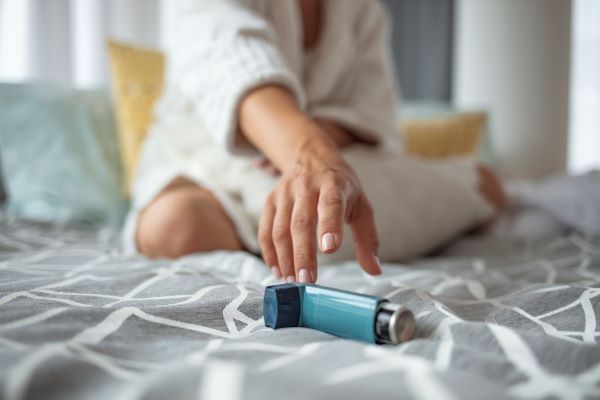Improving the Health of Buildings - Insulation and Air Sealing Could Be Just What the Doctor Ordered

11-01-2022
Is the building where you live, work or study making you sick? Is noise pollution spoiling your concentration or ruining your sleep? Is your home or workplace making you miserable because it is too hot or too cold? Do you suffer from coughs, sneezes, allergies or itchy eyes and you’re not sure why?
Over the years we have become increasingly aware of how buildings can negatively impact our health and well-being — and the challenges of the pandemic have sharpened this focus.
We spend up to 90 percent of our time indoors, so if we’re continuously enduring an environment that’s too cold, noisy, damp, hot, or has poor air quality, that’s going to impact our health and well-being.
Everyone knows it’s a good thing to put healthy food inside our bodies. The same careful consideration should apply when choosing materials that go into building our homes, offices and schools. Especially when they impact our health. Two critical elements to improving building health are insulation and air sealing.
5 ways insulation and air sealing improve home and building health
1. Poor air quality

Even before the pandemic, indoor air quality (IAQ) was becoming an important health issue. Governments had begun regulating what are known as volatile organic compounds (VOCs) in building materials, furnishings, cleaning products and more.
Unhealthy air inside a home can pose serious health risks. The U.S. EPA states that indoor concentrations of pollutants are often two to five times higher than outdoor concentrations. In schools and offices, poor air quality has been linked to absences and low performance.
In addition, a poorly ventilated home combined with dampness is highly likely to have a negative impact on health with the potential to cause respiratory problems such as asthma.
Many people have mistakenly thought they had asthma when it was actually “sick building syndrome,” a set of symptoms that can include headache, sore throat and nausea.
How insulation and air sealing improve Indoor Air Quality
Insulation and air sealing improve air quality by creating dry, warm homes with no cold spots where mold can grow. For schools, public buildings and homes, the installation of Knauf Insulation solutions can really help.
Small gaps in the attic, basement, crawlspace, or garage, allow pollen, dust, water vapor, and many other pollutants to enter, leading to poor indoor air quality. Using an air sealant in these gaps can keep these pollutants out. Air sealing between the living space and the attic also prevents moisture (from cooking, laundry, showers, etc.) from accumulating in the attic and potentially creating mold and moisture issues.
Opt for building products that emit low levels of VOCs, are GREENGUARD certified, and are certified asthma & allergy friendly.®
2. Excessive heat
It’s important to keep buildings cool in summer. Excessive heat isn’t just uncomfortable. It undermines well-being, causes irritation, sleepiness, a lack of concentration, and can lead to illness and death, particularly among the young and elderly, and those living with cardiac, kidney or respiratory diseases. In the U.S., the highest rate of weather-related fatality over the past 30 years has been linked to heat.
The bad news is that hot summers are getting worse. The United States had its hottest summer on record in 2021. And a recent study shows that 37 percent of global heat-related deaths were attributable to climate change.
This is leading to the growth of fuel poverty where an estimated 1.1 billion people are unable to afford access to cooling. From 2010 to 2020, there were approximately 12,000 heat-related premature deaths per year in the U.S.
How insulation and air sealing keep buildings cool
Insulation slows the transfer of heat. That means in summer, insulation acts as a barrier to external heat keeping interiors cooler, which ensures the comfort of building occupants. Air sealing keeps conditioned air inside—and keeps hot outdoor air outside.
3. Excessively cold homes
Nearly a third of all U.S. households are energy insecure, meaning that they are unable to adequately meet household energy needs. Energy insecurity is driven by lack of money and worsened by poor energy efficiency. The more inefficient, the more expensive it is to heat one’s home.
For the vulnerable suffering in the winter, the consequences can be tragic. Each year in the United States, about 1,330 people die of cold exposure. Everyone has the right to a warm comfortable home.
How insulation keeps buildings warm
The North American Insulation Manufacturers Association (NAIMA) estimates that nearly 90 percent of existing homes in America are under-insulated.
Thermal insulation in exterior walls, adequate attic insulation, and air sealing will achieve the most stable indoor temperatures and help keep those inside healthy and warm.
4. Noise pollution

The fact that you can’t see, taste or smell noise may help explain why noise pollution has not received as much attention as air pollution or water pollution. But this invisible danger is affecting millions of Americans who suffer from a range of adverse health outcomes and may not even know noise is the cause.
The World Health Organization (WHO) says that excessive noise seriously damages health, including:
- Disturbed sleep
- Increased stress
- Decreased performance at school or work
- High blood pressure
- Heart disease
Approximately 104 million Americans are at risk of heart disease, hearing loss, and other health effects caused by environmental noise.
How insulation decreases noise pollution
The structure of fiberglass insulation is highly effective at absorbing sound and improving the acoustic comfort of interior spaces. With fiberglass insulation, it is possible to greatly minimize noise pollution in schools, offices, homes, hospitals or any public building. Air sealing can also reduce airborne noise traveling through spaces.
5. Fire hazards
More than 3,000 Americans die in fires each year, according to FEMA, and an average 358,500 homes experience a structural fire each year. The majority deaths are not caused by burns, but by smoke inhalation.
How fiberglass insulation reduces fire risk
Fire risk in buildings must be eliminated from the start and that means ensuring the most efficient building solutions are used from the beginning. At Knauf Insulation we manufacture a wide range of insulation solutions that are certified noncombustible per ASTM E136. Many fiberglass insulation products manufactured by Knauf Insulation have surface burning characteristics of a flame spread index of 25 or less and a smoke developed index of 50 or less, which meets all national building and mechanical codes for insulation. Air sealing can also reduce the draft and how fires spread from one room to another.
These solutions minimize fire risk and its spread which gives people time to leave a burning building and fire fighters more time to tackle the blaze.
It’s clear the buildings where we live, work, and study can have a major impact on our health and wellbeing. We must be aware of the spaces where we spend all our time and simply cannot accept buildings that are potentially taking a toll on our health.
